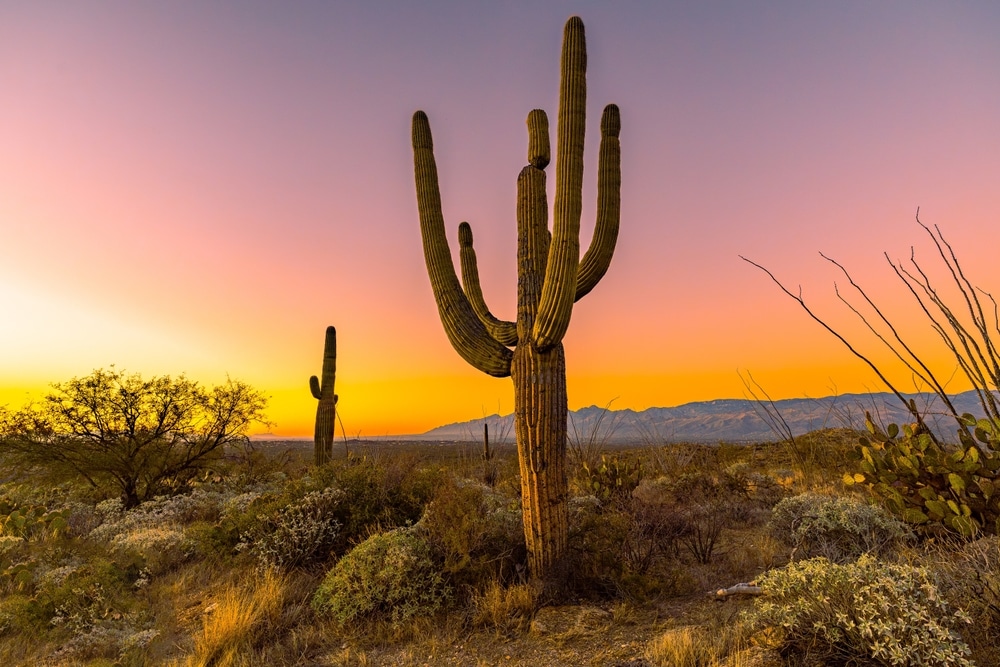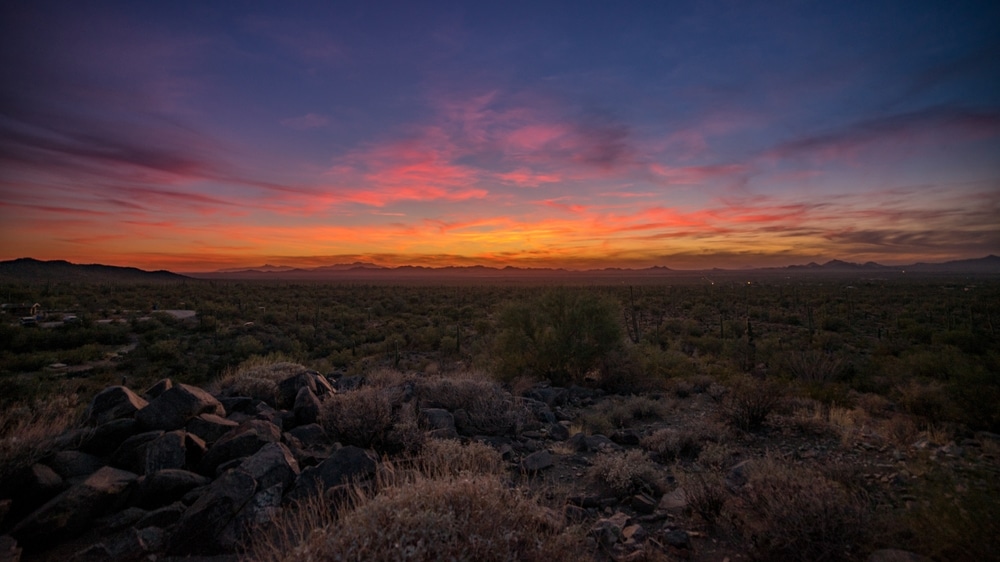Nestled on the eastern and western flanks of Tucson, Saguaro National Park stands as a testament to Arizona’s most recognizable natural symbol—the majestic saguaro cactus. Established initially as a National Monument in 1933 and later designated as a National Park in 1994, this 91,716-acre protected area showcases the Sonoran Desert’s remarkable biodiversity and the iconic saguaro forests that have become synonymous with the American Southwest. The park is uniquely divided into two distinct districts: the Rincon Mountain District (East) and the Tucson Mountain District (West), offering visitors diverse landscapes, recreational opportunities, and perspectives on desert ecology.
The park’s establishment represents one of the earliest conservation efforts specifically designed to protect the saguaro cactus, which can live for up to 200 years and reach heights of 40-60 feet. These remarkable plants, which have become cultural symbols of the American desert, face various threats from urban development, climate change, and invasive species. Today, Saguaro National Park serves not only as a recreational haven but also as a living laboratory for scientific research and a crucial sanctuary for the preservation of Sonoran Desert ecosystems.
With approximately 1 million visitors annually, Saguaro National Park provides a window into both the harsh realities and surprising abundance of desert life. From its diverse plant communities featuring over 50 species of cacti to its remarkable wildlife adaptations, the park offers endless opportunities for discovery, education, and outdoor recreation in one of North America’s most distinctive environments.

Both districts of the park feature scenic drives that offer stunning views of the desert landscape.
Saguaro National Park offers over 165 miles of trails, ranging from easy nature walks to challenging backcountry hikes. Popular trails include:

The park is famous for its spectacular sunsets, with silhouettes of saguaros against fiery skies. Prime spots to watch the sunset include:

The saguaro cactus, the park’s namesake, is the tallest cactus in the U.S., growing up to 50 feet tall and living for over 150 years. The park is the perfect place to learn about these fascinating plants:

Check the park’s schedule for ranger-led activities, including:
These programs are a great way to learn more about the park’s natural and cultural history.

The visitor centers in both districts are excellent starting points for your visit:

The Sonoran Desert is teeming with wildlife, especially in the early morning and evening hours. Animals you might see include:
Bring binoculars to spot elusive species and keep an eye out for snakes and lizards basking on rocks.
The park’s remote location and minimal light pollution make it an excellent spot for stargazing. The desert sky comes alive with stars, planets, and the Milky Way on clear nights. The West District, being farther from Tucson, typically offers darker skies.

For adventurous visitors, backcountry camping is available in the Rincon Mountain District (East). Permits are required, and campsites are located along trails leading into the rugged wilderness of the Rincon Mountains. This is a fantastic way to experience the solitude and beauty of the desert.

| Category | Details |
|---|---|
| Location | Tucson, Arizona, USA |
| Established | October 14, 1994 (originally designated as a monument in 1933) |
| Managed By | National Park Service |
| Size | Approximately 92,000 acres (37,231 hectares) |
| Main Attractions | Giant saguaro cacti, desert landscapes, scenic drives, hiking trails |
| Divisions | Divided into two districts: Rincon Mountain District (East) and Tucson Mountain District (West) |
| Ecosystem | Sonoran Desert with saguaro forests, desert flora, and diverse fauna |
| Wildlife | Includes javelinas, coyotes, Gila monsters, roadrunners, and desert tortoises |
| Nearby Landmarks | Tucson, Arizona-Sonora Desert Museum, Sabino Canyon Recreation Area |
| Visitor Activities | Hiking, biking, photography, wildlife viewing, scenic drives, and ranger-led programs |
| Trails | Popular trails include the Valley View Overlook Trail (West) and Loma Verde Loop (East) |
| Climate | Hot summers, mild winters, with monsoon rains in late summer |
| Entrance Fee | $25 per vehicle (valid for 7 days; fees subject to change) |
| Accessibility | Visitor centers and some trails are wheelchair accessible |
| Fun Fact | The park is home to some of the largest saguaros, which can live over 150 years and grow up to 50 feet tall! |
Saguaro National Park’s unique two-district configuration makes it exceptionally accessible to visitors. The Rincon Mountain District (East) lies approximately 15 miles east of downtown Tucson off Speedway Boulevard, while the Tucson Mountain District (West) is situated about 15 miles west of the city center via Gates Pass Road or Speedway Boulevard.
The park’s split nature is more than a geographical curiosity—it represents two distinctly different Sonoran Desert ecosystems separated by metropolitan Tucson:
Rincon Mountain District (East): Features higher elevation ranges (from 2,670 to 8,666 feet at Mica Mountain) with more varied vegetation zones, from desert scrub at lower elevations to pine forests at the highest points.
Tucson Mountain District (West): Generally lower in elevation (2,180 to 4,687 feet) with denser saguaro forests and a more classic desert landscape.
Both districts are easily accessible by car from Interstate 10, which runs through Tucson. The East district is reached via the Broadway/Speedway exits, while the West district can be accessed from the Avra Valley Road or Speedway Boulevard exits.
Public transportation options are limited, though Tucson’s Sun Tran bus service does provide routes that can get visitors relatively close to park entrances. Many visitors opt to use rideshare services to reach the park from Tucson accommodations.
Each district features a scenic loop drive that provides excellent access to trailheads and viewpoints:
Cactus Forest Drive (East): An 8-mile paved loop road
Bajada Loop Drive (West): A 6-mile graded dirt road suitable for most vehicles
Each district has a well-appointed visitor center that serves as an ideal starting point for park exploration:
Rincon Mountain Visitor Center (East): Open daily from 9:00 AM to 5:00 PM
Red Hills Visitor Center (West): Open daily from 9:00 AM to 5:00 PM
Both centers offer interpretive exhibits, ranger assistance, educational materials, and bookstores. The centers provide accessible facilities, including restrooms, water filling stations, and accessible parking.
The park’s namesake, the saguaro cactus (Carnegiea gigantea), is North America’s largest cactus and occurs naturally only in the Sonoran Desert. These botanical marvels can:
A single saguaro can produce up to 40 million seeds during its lifetime, though very few will successfully grow into mature plants. The park protects some of the densest and most pristine saguaro forests remaining in the United States.
Beyond the saguaros, the park protects six distinct biotic communities:
Desert Scrub: Dominated by saguaros, palo verde trees, creosote bush, and various cacti
Desert Grassland: Featuring native grasses, mesquite, and scattered cacti
Oak Woodland: At middle elevations with several species of oak trees
Pine-Oak Woodland: Transitional zone with both oak and pine species
Pine Forest: At higher elevations in the Rincon Mountains
Mixed Conifer Forest: Found at the highest elevations of the Rincon Mountains
This ecological diversity is particularly remarkable given the park’s desert setting and relatively small size. The East district’s Rincon Mountains rise high enough to create a “sky island” effect, where isolated mountain ranges harbor ecosystems typically found at much more northern latitudes.
The park serves as habitat for an impressive array of desert-adapted wildlife:
Mammals: Includes javelina, coyotes, bobcats, black bears (in high elevations), white-tailed deer, and numerous bat species
Birds: Over 200 species documented, including Gila woodpeckers and gilded flickers (which create nest holes in saguaros), cactus wrens, roadrunners, and various raptors
Reptiles: Home to the Gila monster, desert tortoise, and numerous snake species (including rattlesnakes)
Amphibians: Several species of toads and frogs that emerge during the monsoon season
Invertebrates: Countless species of insects, including many pollinators essential to desert plant reproduction
Many of these animals are nocturnal or crepuscular (active at dawn and dusk), adapting to avoid the intense daytime heat of the desert.
The park’s geology tells a story spanning millions of years:
With over 165 miles of trails between both districts, hiking is the premier activity at Saguaro National Park. Popular trails include:
Cactus Forest Trail: A relatively flat 2.5-mile loop through saguaro forests
Tanque Verde Ridge Trail: A challenging 9-mile (one-way) trail climbing from desert to pine forest with 4,000 feet of elevation gain
Douglas Spring Trail: A 6-mile (one-way) trail to Douglas Spring Campground with options for longer backpacking routes
Mica View Loop: An easy 2-mile loop suitable for families
Valley View Overlook Trail: A short 0.8-mile round trip to panoramic views
King Canyon Trail: A moderate 3.5-mile trail leading to Wasson Peak, the highest point in the Tucson Mountains
Hugh Norris Trail: A 4.9-mile (one-way) scenic trail with spectacular ridge views
Desert Discovery Nature Trail: A 0.5-mile accessible loop with interpretive displays
Hiking is best enjoyed from October through April when temperatures are moderate. Summer hiking should be limited to early morning hours due to extreme heat, with hikers carrying at least one gallon of water per person.
Both districts offer scenic driving loops that provide access to the park’s landscapes:
Cactus Forest Drive (East): This 8-mile paved loop road offers numerous pullouts with interpretive signs and access to trailheads.
Bajada Loop Drive (West): A 6-mile dirt road (generally passable in passenger vehicles) showcasing dense saguaro forests and desert landscapes.
These drives are particularly spectacular at sunrise and sunset when the desert light creates dramatic landscapes.
The park offers exceptional opportunities for wildlife observation and nature photography:
Many photographers seek to capture the classic image of a saguaro silhouette against a colorful sunset sky, with the best opportunities along the park’s western-facing slopes.
The East district offers wilderness camping opportunities in six designated campgrounds in the Rincon Mountains:
The West district does not offer overnight camping options.
The park offers a variety of educational programs led by knowledgeable rangers:
Program schedules vary seasonally and are posted at visitor centers and on the park’s website.
Saguaro National Park’s relatively dark skies make it an excellent location for stargazing:
Visitors should bring red-filtered flashlights to preserve night vision and respect closing hours, as most park areas are not open for overnight use except for permitted backcountry campers.
Saguaro National Park experiences distinctive seasonal changes that significantly impact the visitor experience:
Generally pleasant with daytime temperatures ranging from 70-85°F and cool evenings. An excellent time for hiking and outdoor activities with reduced crowds.
Mild daytime temperatures averaging 65-70°F with cold nights that can occasionally drop below freezing at higher elevations. The Rincon Mountains may receive snow at higher elevations. Lower visitor numbers make this a peaceful time to explore.
Perhaps the most popular season with comfortable temperatures ranging from 70-85°F. This period typically features wildflower blooms, depending on winter rainfall patterns. Visitation increases significantly during spring break periods.
Characterized by extreme heat with daytime temperatures routinely exceeding 100°F, sometimes reaching 110°F or higher. The monsoon season (July-September) brings afternoon thunderstorms, flash flood dangers, and dramatic cloud formations. Early morning visits are essential during summer months.
The park’s biological calendar offers changing highlights throughout the year:
December-January: Barrel cactus may bloom; relatively quiet period biologically
February-April: Peak wildflower season (intensity varies based on winter rainfall)
April-June: Saguaro flowering period, with blossoms typically opening at night and closing by mid-morning
June-July: Saguaro fruit ripens, historically harvested by the Tohono O’odham people
July-September: Monsoon rains trigger a second growing season with summer wildflowers and increased animal activity
October-November: Cooler temperatures bring increased daytime wildlife activity
Understanding visitation patterns can help plan a more enjoyable experience:
Peak Season: March-April (spring break) and winter holidays see the highest visitation
Moderate Season: October-February (excluding holidays) offers pleasant weather and moderate crowds
Low Season: May-September has the lowest visitation due to extreme heat, though early mornings can be quite pleasant
The East district typically receives more visitors than the West, though both can become busy during peak periods. Weekdays generally offer a more peaceful experience than weekends.
The lands encompassing Saguaro National Park have been home to Indigenous peoples for thousands of years:
The park works collaboratively with tribal communities on various programs, including cultural demonstrations and educational initiatives.
The protection of Saguaro National Park evolved over decades:
1920s: Concerned citizens began advocating for protection of the saguaro forests
1933: President Herbert Hoover established Saguaro National Monument in the Rincon Mountain District
1961: President John F. Kennedy added the Tucson Mountain District to the monument
1976: Congress designated the Saguaro Wilderness Area within the monument
1994: Legislation elevated the monument to National Park status
The park’s development represents one of America’s earliest conservation efforts focused specifically on plant preservation rather than scenic landscapes.
Several historical features within the park provide glimpses into human history:
Manning Cabin: A historic cabin built in 1905 as a summer retreat, located in the high country of the Rincon Mountains
Civilian Conservation Corps (CCC) structures: Including stone erosion-control structures built during the Great Depression
Historical lime kilns: Remnants of 19th-century commercial lime production in the Tucson Mountains
Old homestead sites: Scattered through both districts, representing early Anglo settlement attempts
Saguaro National Park collects entrance fees that support park operations and improvements:
Vehicle Pass: $25 (valid for 7 consecutive days in both districts)
Motorcycle Pass: $20 (valid for 7 consecutive days in both districts)
Individual Pass (pedestrian/bicycle): $15 (valid for 7 consecutive days in both districts)
Saguaro Annual Pass: $45 (valid for 12 months from purchase date)
The park also accepts all National Park Service passes, including:
Various activities within the park require permits:
Backcountry Camping: Permits required for all overnight stays in the wilderness areas ($8 per campsite plus $5 reservation fee)
Commercial Photography/Filming: Commercial activities require special permits
Research Activities: Scientific research requires research permits
Special Events: Weddings and organized group activities require permits
Important regulations to observe include:
The park strives to provide accessible experiences for all visitors:
Visiting the desert environment safely requires preparation and awareness:
Summer temperatures frequently exceed 100°F. Limit activity to early morning hours (before 10 AM) during hot months.
Carry at least one gallon per person per day for hiking. No reliable water sources exist on trails.
Trails can be difficult to follow in some areas. Carry maps and watch for cairns marking routes.
Rattlesnakes, scorpions, and other venomous creatures are present. Stay on trails, check before placing hands or feet, and never harass wildlife.
Wear wide-brimmed hats, sunglasses, long sleeves, and use SPF 30+ sunscreen.
Avoid arroyos (dry washes) during thunderstorms, as flash flooding can occur rapidly.
Cell phone coverage is unreliable, particularly in the East district backcountry.
Saguaro National Park faces numerous conservation challenges:
Urban Encroachment: Tucson’s growth continues to isolate the park from other natural areas
Invasive Species: Buffelgrass and other non-native plants threaten to transform the ecosystem and increase fire risk
Climate Change: Increasing temperatures and changing precipitation patterns affect saguaro reproduction and survival
Vandalism: Damage to saguaros (including shooting and carving) continues to be a problem
Air Quality: Pollution from urban areas impacts visibility and ecosystem health
Water Resources: Groundwater depletion affects the park’s natural springs and vegetation
Visitors can help protect the park through responsible practices:
Saguaro National Park stands as one of Arizona’s most distinctive natural treasures—a place where the iconic symbol of the American West, the saguaro cactus, is protected in its natural desert habitat. The park’s two districts offer complementary experiences that showcase the remarkable biodiversity and cultural significance of the Sonoran Desert ecosystem.
Beyond its obvious scenic beauty, the park serves as a living laboratory for scientific research, a cultural touchstone connecting past and present, and a recreational haven where visitors can experience the unique character of the Sonoran Desert. As climate change and urban growth continue to pressure desert ecosystems, Saguaro National Park’s role in conservation becomes increasingly vital.
For visitors, the park offers a chance to connect with a landscape that seems at once harsh and surprisingly abundant with life. Whether marveling at a star-filled desert night, watching the sun illuminate a forest of saguaro silhouettes at dawn, or discovering the remarkable adaptations that allow desert creatures to thrive in extreme conditions, time spent at Saguaro National Park provides opportunities for wonder, learning, and renewal.
As we look to the future, the preservation of this unique environment depends on continued stewardship, scientific research, and public engagement. Each visitor who leaves with a deeper appreciation for the desert and its ecological importance helps ensure that future generations will also experience the majesty of the Sonoran Desert’s saguaro forests.